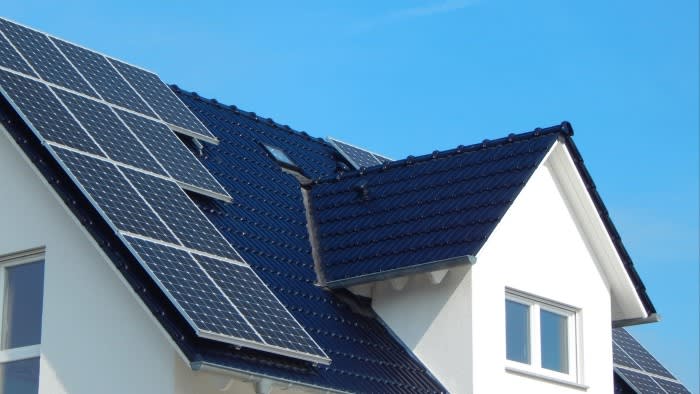This article is an on-site version of our Moral Money newsletter. Premium subscribers can sign up here to get the newsletter delivered three times a week. Standard subscribers can upgrade to Premium here, or explore all FT newsletters.
Visit our Moral Money hub for all the latest ESG news, opinion and analysis from around the FT
Welcome to our coverage of New York Climate Week. It was good to see some Moral Money readers at Gillian Tett’s place last night for her annual Climate Week kick-off party. If your schedule isn’t too packed already, we have a number of events you can check out here. If you are at the United Nations later today, I am interviewing Achim Steiner, the administrator of the United Nations Development Programme, and others about financing a fairer future.
For today, Lee has a piece about the power of green banks, which can serve a crucial role in lending for sustainability projects that commercial players won’t touch.
See you around town this week. — Patrick Temple-West
Climate finance
Green banks steer $20bn in federal funds to poorer borrowers
Lending by public banks, credit unions and community development financial institutions in the US has come under pressure in recent years, partly due to regulation following the global financial crisis that some argue has driven a wave of consolidation by private-sector banks.
One type of not-for-profit banking, however, is taking off. The number of green banks across the US has more than tripled since 2019, going from under a dozen to nearly fifty, according to Kirsten Stasio, founding chief executive of the Nevada Clean Energy Fund, the state’s green bank.
Stasio was tapped to lead a new consortium of green banks, the US Green Bank 50 (GB 50), that is launching today as New York Climate Week kicks off.
Green banks got a major shot in the arm from one of the White House’s biggest programmes to cut pollution and finance green tech, which was designed to flow through the public and community bank system.
GB 50 is a sign of maturity for the industry. The group aims to help members strategise on deploying the chunky $20bn in grants earmarked for green banks and regional lenders in the Inflation Reduction Act, President Joe Biden’s signature climate law.
The White House has predicted that the programme could attract $7 in private lending for every federal dollar spent, unleashing as much as $150bn into projects that range from making buildings more energy efficient to providing loans for low-income families to buy electric vehicles.
The administration has instructed lenders to prioritise poorer borrowers, including groups that have historically faced obstacles to obtaining funding. The fund will also provide low-interest loans to local entities such as school districts and tribal governments.
Green banks are typically capitalised by government at the state or federal level — not private depositors — and make loans that are repaid and used to back new projects. While they are typically willing to accept a lower rate of return, Stasio told me, targeting low-income groups and individuals with lower credit scores doesn’t necessarily mean taking on more risk. Often, it just requires more “overhead” — additional investments of time and resources to make a project viable.
For example, some green banks use alternative criteria to assess loan eligibility, such as evaluating a borrower’s ability to repay a loan for a more energy-efficient heat pump, rather than relying on a traditional credit score.
Green banks originate loans that would be passed over by private lenders, Stasio said, because “cheque size is too small, perceived risk is too high, or too much [education or technical assistance] is needed”.
Decarbonising the more than 110mn buildings across the US (of which roughly 90 per cent are single-family homes, according to the Institute for Progress think-tank) will require a small army of lenders and contractors willing to assess the viability of projects from tearing out gas boilers to insulating draughty attics.
These overhauls can be costly to evaluate, and many of the old, leaky buildings most in need of repairs are occupied by families that lack the savings to finance them — even when they could lower energy bills in the long run.
Green banks, Stasio said, provide the “boots on the ground to engage with contractors and interface directly with households”.
Most of the billions in green financial support the IRA made available are structured as tax breaks — a legacy of the law’s wafer-thin support in a divided Congress. Tax-exempt entities such as public power utilities can still access the financing, but many borrowers will require bridge financing before they can file for reimbursement on eligible projects.
GB 50 plans to advise smaller borrowers on how they can tap into those loans, and help co-ordinate green banks’ efforts to speed up the diffusion of funding.
That diffusion is becoming all-important as the White House races to get money out of the door before January of next year, when a Republican-controlled Congress or presidential administration could potentially gut the programme.
But getting the finance flowing takes time — and employees. Philanthropic organisations such as Invest In Our Future, backed by the Rockefeller Foundation, have funded efforts to help borrowers apply for the billions in grants made available by the IRA. While GB 50 is a start, green banks need more operating capital, Stasio said. “We are absolutely understaffed.” (Lee Harris)
Smart read
The FT editorial board highlights the importance of emissions trading schemes, which establish a price for carbon, in this important editorial.
Recommended newsletters for you
FT Asset Management — The inside story on the movers and shakers behind a multitrillion-dollar industry. Sign up here
Energy Source — Essential energy news, analysis and insider intelligence. Sign up here
https://www.ft.com/content/34adcbd5-13d4-4df4-b494-5c3a2d7a949f


